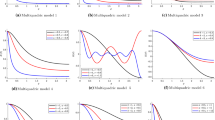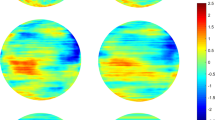Abstract
This paper presents the characterization of the covariance matrix function of a Gaussian or second-order elliptically contoured vector random field on the sphere which is stationary, isotropic, and mean square continuous. This characterization involves an infinite sum of the products of positive definite matrices and Gegenbauer’s polynomials, and may not be available for other non-Gaussian vector random fields on spheres such as a χ 2 or log-Gaussian vector random field. We also offer two simple but efficient constructing approaches, and derive some parametric covariance matrix structures on spheres.
Similar content being viewed by others
References
Bapat RB, Raghavan TES (1997) Nonnegative matrices and applications. Cambridge University Press, Cambridge
Bingham NH (1973) Positive definite functions on spheres. Proc Camb Philos Soc 73:145–156
Calder CA (2007) Dynamic factor process convolution models for multivariate space–time data with application to air quality assessment. Environ Ecol Stat 14:229–247
Chen D, Menegatto A, Sun X (2003) A necessary and sufficient condition for strictly positive definite functions on spheres. Proc Am Math Soc 131:2733–2740
Chilés, JP, Delfiner P (1999) Geostatistics: modeling spatial uncertainty. Wiley, New York
Choi J, Reich B, Fuentes M, Davis J (2009) Multivariate spatial-temporal modeling and predication of speciated fine particles. J Statist Theory Pract 3:407–418
Christensen JPR, Ressel P (1978) Functions operating on positive definite matrices and a theorem of Schoenberg. Trans Am Math Soc 243:89–95
Cohen A, Johns RH (1969) Regression on a random field. J Am Stat Assoc 64:1172–1182
Cressie N (1993) Statistics for spatial data, revised edn. Wiley, New York
Dimitrakopoulos RD, Mustapha H, Gloaguen E (2010) High-order statistics of spatial random fields: exploring spatial cumulants for modeling complex non-Gaussian and non-linear phenomena. Math Geosci 42:65–99
Du J, Ma C (2011) Spherically invariant vector random fields in space and time. IEEE Trans Signal Process 59:5921–5929
Du J, Ma C (2012) Variogram matrix functions for vector random fields with second-order increments. Math Geosci 44:411–425
Feller W (1971) An introduction to probability theory and its applications, vol. II, 2nd edn. Wiley, New York
Gaspari G, Cohn SE (1999) Construction of correlations in two and three dimensions. Q J R Meteorol Soc 125:723–757
Gaspari G, Cohn E, Guo J, Pawson S (2006) Construction and application of covariance functions with variable length-fields. Q J R Meteorol Soc 132:1815–1838
Haas TC (1998) Multivariate spatial prediction in the presence of non-linear trend and covariance non-stationarity. Environmetrics 7:145–165
Hannan EJ (1966) Spectral analysis for geophysical data. Geophys J R Astron Soc 11:225–236
Hannan EJ (1969) Fourier methods and random processes. Bull Internat Statist Inst 42:475–496
Hannan EJ (1970) Multiple time series. Wiley, New York
Huang C, Yao Y, Cressie N, Hsing T (2009) Multivariate intrinsic random functions for cokriging. Math Geosci 41:887–904
Huang C, Zhang H, Robeson SM (2011) On the validity of commonly used covariance and variogram functions on the sphere. Math Geosci 43:721–733
Johns RH (1963a) Stochastic processes on a sphere. Ann Math Stat 34:213–218
Johns RH (1963b) Stochastic processes on a sphere as applied to meteorological 500-millibar forecasts. Proceedings of the symposium of time series analysis, vol 119. Wiley, New York
Jun M (2011) Non-stationary cross-covariance models for multivariate processes on a globe. Scand J Stat 38:726–747
Le ND, Zidek JV (2006) Statistical analysis of environmental space–time processes. Springer, New York
Ma C (2011a) Vector random fields with second-order moments or second-order increments. Stoch Anal Appl 29:197–215
Ma C (2011b) Covariance matrices for second-order vector random fields in space and time. IEEE Trans Signal Process 59:2160–2168
Ma C (2011c) Covariance matrix functions of vector χ 2 random fields in space and time. IEEE Trans Commun 59:2254–2561
Mangulis V (1965) Handbook of series for scientists and engineers. Academic Press, New York
Mardia KV (1988) Multi-dimensional multivariate Gaussian Markov random fields with application to image processing. J Multivar Anal 24:265–284
Matérn B (1986) Spatial variation, 2nd edn. Springer, New York
Matheron G (1989) The internal consistency of models in geostatistics. In: Armstrong M (ed) Geostatistics, vol 1. Kluwer Academic, Dordrecht, pp 21–38
McLeod MG (1986) Stochastic processes on a sphere. Phys Earth Planet Inter 43:283–299
Roy R (1972) Spectral analysis for random field on the circle. J Appl Probab 9:745–757
Roy R (1973) Estimation of the covariance function of a homogeneous process on the sphere. Ann Stat 1:780–785
Roy R (1976) Spectral analysis for a random process on the sphere. Ann Inst Stat Math 28:91–97
Sain R, Cressie N (2007) A spatial model for multivariate lattice data. J Econom 140:226–259
Sain R, Furrer R, Cressie N (2011) A spatial analysis of multivariate output from regional climate models. Ann Appl Stat 5:150–175
Schoenberg I (1942) Positive definite functions on spheres. Duke Math J 9:96–108
Szegö G (1959) Orthogonal polynomials. Amer. Math. Soc. Colloq. Publ., vol 23. Amer. Math. Soc., Providence
Tebaldi C, Lobell DB (2008) Towards probabilistic projections of climate change impacts on global crop yields. Geophys Res Lett 35:L08705. doi:10.1029/2008GL033423
Trenberth KE, Shea DJ (2005) Relationships between precipitation and surface temperature. Geophys Res Lett 32:L14703. doi:10.1029/2005GL022760
Watson GN (1944) A treatise on the theory of Bessel functions, 2nd edn. Cambridge University Press, London
Weaver A, Courtier P (2001) Correlation modelling on the sphere using a generalized diffusion equation. Q J R Meteorol Soc 127:1815–1846
Widder DV (1946) The Laplace transform. Princeton Univ. Press, Princeton
Yadrenko AM (1983) Spectral theory of random fields, Optimization Software, New York.
Yaglom AM (1987) Correlation theory of stationary and related random functions, vol. I. Springer, New York
Zidek JV, Sun W, Le ND (2000) Designing and integrating composite networks for monitoring multivariate Gaussian pollution fields. J R Stat Soc, Ser C, Appl Stat 49:63–79
Acknowledgements
This work is supported in part by U.S. Department of Energy under Grant DE-SC0005359, in part by the Kansas NSF EPSCoR under Grant EPS0903806, and in part by a Kansas Technology Enterprise Corporation grant. The author would like to thank an associate editor and two anonymous reviewers for their valuable comments and suggestions which helped to improve the presentation of this paper.
Author information
Authors and Affiliations
Corresponding author
Appendix: Proof of Theorem 2
Appendix: Proof of Theorem 2
Suppose that C(θ) is the covariance matrix function of an m-variate stationary and isotropic random field \(\{ \mathbf {Z}(\mathbf{x}), \mathbf{x}\in \mathbb{S}^{\infty}\}\). Then C ij (θ)=C ji (θ),θ∈[0,π], i,j=1,…,m. According to Theorem 2 of Schoenberg (1942), for each k∈{1,…,m}, the direct covariance function C kk (θ) of a component random field \(\{ Z_{k} (\mathbf{x}), \mathbf{x}\in\mathbb{S}^{\infty}\}\) possesses an ultraspherical expansion

where {b n (k,k),n=0,1,…} is a summable sequence of nonnegative numbers. Similarly, for i≠j, a scalar random field \(\{ Z_{i} (\mathbf {x})+Z_{j} (\mathbf{x} ), \mathbf{x}\in\mathbb{S}^{\infty}\}\) has the covariance function C ii (θ)+C jj (θ)+2C ij (θ) that possesses an ultraspherical expansion

and a scalar random field \(\{ Z_{i} (\mathbf{x})-Z_{j} (\mathbf{x}), \mathbf {x}\in\mathbb{S}^{\infty}\}\) has the covariance function C ii (θ)+C jj (θ)−2C ij (θ) that possesses an ultraspherical expansion

Taking the difference of Eqs. (12) and (13), we obtain

where \(b_{n} (i, j) = \frac{1}{4} (e^{+}_{n} (i, j)-e^{-}_{n} (i, j)), n = 0, 1, \ldots, i, j =1, 2, \ldots, m\). It follows from Eqs. (11) and (14) that C(θ) adopts an expansion like Eq. (6). Therefore, it remains to show that B n =(b n (i,j)) m×m is positive definite, for each nonnegative integer n. To this end, suppose that a 1,…,a m are arbitrary real numbers. Using these constants, we formulate a scalar random field \(\{ \sum_{k=1}^{m} a_{k} Z_{k} (\mathbf{x}), \mathbf{x}\in\mathbb {S}^{\infty}\}\). This is a second-order random field on \(\mathbb{S}^{\infty}\) with covariance function

where the second equality follows from Eqs. (11) and (14). Applying Theorem 2 of Schoenberg (1942) to the last expansion, we obtain that all its coefficients a′B n a are nonnegative, that is, each B n =(b n (i,j)) m×m is positive definite.
On the other hand, let C(θ) be an m×m matrix function with expansion of Eq. (6). For each n≥0, it is known (Schoenberg 1942) that cosn θ is positive definite on \(\mathbb{S}^{\infty}\), and thus 1cosn θ is a covariance matrix function, where 1 is an m×m matrix with all entries equal 1. By Theorem 6 of Ma (2011b), the Hadamard product of B n and 1cosn θ, which is the same as B n cosn θ, is also a covariance matrix function on \(\mathbb{S}^{\infty}\). So is C(θ), the sum of the sequence {B n cosn θ,n=0,1,2,…}.
Rights and permissions
About this article
Cite this article
Ma, C. Stationary and Isotropic Vector Random Fields on Spheres. Math Geosci 44, 765–778 (2012). https://doi.org/10.1007/s11004-012-9411-8
Received:
Accepted:
Published:
Issue Date:
DOI: https://doi.org/10.1007/s11004-012-9411-8




